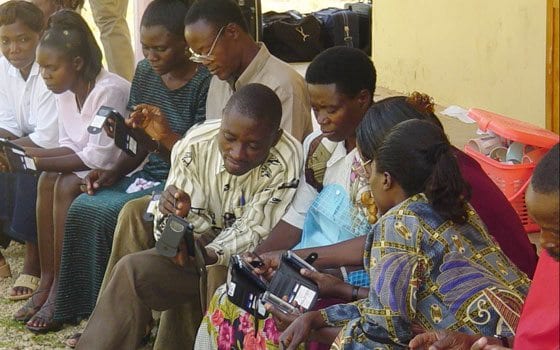
In recent years, technological innovations have helped bring political, economic and social advances to many countries in the developing world. One Watertown-based nonprofit is following suit and contributing to the spread of critical health care services throughout Africa.
Through its “Health in Hand” project, the Academy for Educational Development (AED)-SATELLIFE Center for Health Information and Technology provides health workers in Uganda with handheld computers that give them access to medical information needed for disease prevention, diagnosis and treatment.
Since the organization’s inception, AED-SATELLIFE has helped promote information exchanges with over 120,000 health practitioners serving millions of patients in 154 countries. Its recent efforts have focused on Uganda, where the organization has distributed more than 600 solar-charged mobile computers, all pre-loaded with relevant digital public health information, in 174 rural clinics throughout the east African nation.
“Medical journals are expensive and hard to get in Africa,” said AED-SATELLIFE Senior Development Officer Andrew Sideman. “The Internet has created new opportunities to get information out to people even in the most remote parts of the country.”
The handheld devices are connected to a computer server in the Ugandan capital city of Kampala as part of a two-way system run by the Uganda Health Information Network. The server sends out new medical information multiple times a week. In turn, the health workers using the devices can send back e-mails about health emergencies.
Before the mobile computers became available, medical information was passed throughout the country on paper, having to travel through many hands before reaching its destination. Unfortunately, by the time it got to the right people, the information was often outdated or just too late to help anyone.
“Let’s say there is a tuberculosis breakout; the health worker can send a message to Kampala, and then the Kampala health ministry can notify other health workers immediately,” Sideman said. “Everyone will have the same information at the same time, and possibly help save lives.”
In addition to enabling them to stay abreast of medical innovation, the devices have also aided the creation of a sense of community among many health workers, now able to send messages to each other and feel connected in their battle against illnesses in the east African nation. The devices have also had a positive effect on women’s empowerment. Most of the medical practitioners getting these devices are women, who are now seen as role models with the ability to be self-sufficient leaders in their communities.
Berhane Gebru, project manager for the initiative, said that this type of technological innovation gives hope to health workers in rural areas, who have seen the “brain drain” of many educated African professionals leaving the continent for greener pastures in Western hospitals.
“For many rural workers, these computers are the only source of information they have to what is going on outside of [the] village,” Gebru said. “When they get messages, they feel connected to the larger medical community.”
For all the goodwill the initiative has brought to Uganda’s medical community, there are some drawbacks.
As it stands, only one device is being distributed to one person per village. If those health workers have to leave their villages even temporarily, they usually take the computers, as they are likely to be the only individuals trained to use them, which can leave entire villages disconnected.
Other issues include the cost of the devices and the need for more instructors in Uganda to train health workers on how to use the computers.
The project is working to address those concerns, looking to raise enough funds to purchase more than 1,200 additional devices and to expand its digital medical library. The organization is also working to hire more computer trainers.
Despite the uphill battles, for Sideman, the medical benefits outweigh the logistical problems: To date, over 1 million Ugandans have benefited from the Health in Hand initiative.
“Technology is great for everyone,” Sideman said. “This is only the beginning for even greater advancing in health on the continent.”






